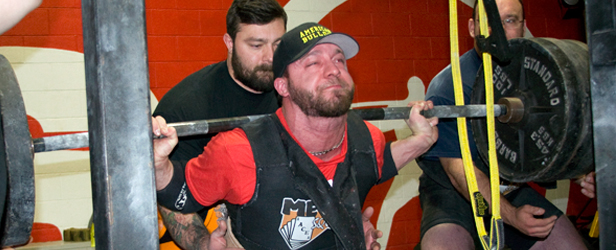Deleted member 43589
Well-Known Member
I don't talk much about powerlifting and strength much anymore since I retired from the sport 13 years ago. Later in my competitive career I was lucky enough to meat Dr. Fred Hatfield, who was also one of the legends in the sport of powerlifting. I talked to Hatfield frequently by email and phone and learned a lot about the more scientific end of the sport. It was Dr, Hatfield who taught be about Compensatory acceleration training or CAT. He said this is the type of training that will take you lifting from good to being the best.
Compensatory acceleration training involves trying to move a given weight as quickly as possible throughout the range of motion of a lift. Using the simple equation of force = mass x acceleration, we understand the faster we accelerate a given weight, the more force we can generate and put into a movement, thus we get stronger. This is accomplished by using CAT in lighter warm up weights and teaching the mind and muscle how to work explosively and generate maximal force through a lift. As we teach the mind and muscles how to maximally fire in light weight, we can eventually transfer this skill over to the heavy weight.
Dr Hatfield said: "If you’re applying a thousand pounds of force at the bottom of the lift and then as leverage improves you continue to apply a thousand pounds or less, you’re not accomplishing as much as you can. Instead, you’ll see that as leverage improves, you’re able to apply twelve hundred pounds of force, fourteen hundred pounds of force up near the top. The secret though is that you’re applying as much force as you possibly can exert all the way through the lift. That means you’re spending more time under maximum tension. That means you’re going to make progress much faster than you could otherwise, probably twice as fast."
For most people, generating enough force at the bottom is not as hard as it is when the bar travels upwards against gravity and tends to slow. At that pint you have to be able to generate even more force and move the bar through the sticking point to the top of the lift. So you have to take off like a rocket is attached and keep the generation of force going through the lift. So ask Dr, Hatfield said, if you have to generate 1000lbs for force at the bottom of a lift to get it moving, you must be able to generate 1200lbs and then 1400lbs as the bar move up to the top of the lift. This seems hard to do unless you practice it with light weight and train the body and mind to work together.
My total over the years went from 1690 to 2275 when I retired. I was always stuck with a 650lb squat and 650lb deadlift but after using CAT for a few years I quickly went to a 950 squat and 800lb deadlift putting me as ranked #1 as #2 in two different weight classes at the top of my career by Powerliifting USA. Not so bad by a tall skinny guy who looked like he was never going to make much in this sport.
This type of training and the idea behind it quickly lead to powerlifters using rubber bands and chains regularly in their training. A lot of these ideas were also combined with the training protocol of Westside Barbell.
There are several studies done investigating the use of CAT in athletes of all kinds.

 journals.lww.com
journals.lww.com

 journals.lww.com
journals.lww.com

 www.elitefts.com
www.elitefts.com
Compensatory acceleration training involves trying to move a given weight as quickly as possible throughout the range of motion of a lift. Using the simple equation of force = mass x acceleration, we understand the faster we accelerate a given weight, the more force we can generate and put into a movement, thus we get stronger. This is accomplished by using CAT in lighter warm up weights and teaching the mind and muscle how to work explosively and generate maximal force through a lift. As we teach the mind and muscles how to maximally fire in light weight, we can eventually transfer this skill over to the heavy weight.
Dr Hatfield said: "If you’re applying a thousand pounds of force at the bottom of the lift and then as leverage improves you continue to apply a thousand pounds or less, you’re not accomplishing as much as you can. Instead, you’ll see that as leverage improves, you’re able to apply twelve hundred pounds of force, fourteen hundred pounds of force up near the top. The secret though is that you’re applying as much force as you possibly can exert all the way through the lift. That means you’re spending more time under maximum tension. That means you’re going to make progress much faster than you could otherwise, probably twice as fast."
For most people, generating enough force at the bottom is not as hard as it is when the bar travels upwards against gravity and tends to slow. At that pint you have to be able to generate even more force and move the bar through the sticking point to the top of the lift. So you have to take off like a rocket is attached and keep the generation of force going through the lift. So ask Dr, Hatfield said, if you have to generate 1000lbs for force at the bottom of a lift to get it moving, you must be able to generate 1200lbs and then 1400lbs as the bar move up to the top of the lift. This seems hard to do unless you practice it with light weight and train the body and mind to work together.
My total over the years went from 1690 to 2275 when I retired. I was always stuck with a 650lb squat and 650lb deadlift but after using CAT for a few years I quickly went to a 950 squat and 800lb deadlift putting me as ranked #1 as #2 in two different weight classes at the top of my career by Powerliifting USA. Not so bad by a tall skinny guy who looked like he was never going to make much in this sport.
This type of training and the idea behind it quickly lead to powerlifters using rubber bands and chains regularly in their training. A lot of these ideas were also combined with the training protocol of Westside Barbell.
There are several studies done investigating the use of CAT in athletes of all kinds.

The Effects of Compensatory Acceleration on Upper-Body... : The Journal of Strength & Conditioning Research
e platform plyometric push-up test (n = 24). Upper-body strength was tested by using a bench press with 1 repetition maximum (1RM) (n = 30). All players were on an identical off-season weight-training program. The control group performed exercises with conventional concentric velocity and the...

Contemporary Training Practices in Elite British... : The Journal of Strength & Conditioning Research
in light of anecdotal evidence purporting increased similarity with the explosive training practices of weightlifters. The study also assessed the prevalence of contemporary training practices frequently recommended for powerlifters in the popular literature. A 20-item survey was distributed to...

Compensatory Acceleration Training: Maximizing Each Rep, Each Set
I am going to introduce a concept I call “movement intention.”
















